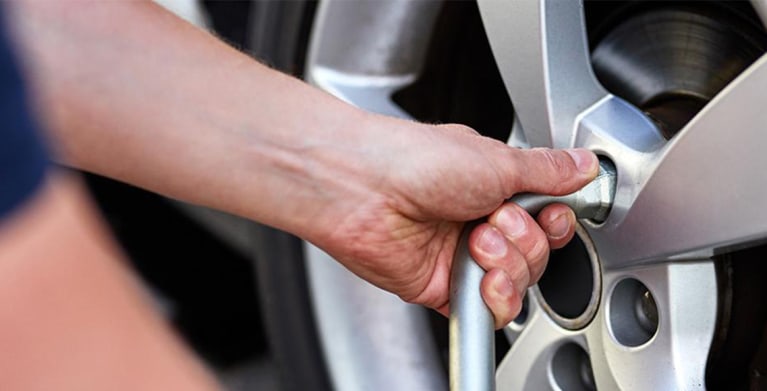Drive with Confidence: GMC Tires Service at Morris Tires
Drive with Confidence: GMC Tires Service at Morris Tires
Blog Article
Tire Solution: The Impact of Weather Condition Conditions
When it comes to making certain ideal performance and safety and security on the roadway, understanding the impact of weather condition conditions on tire solution is essential. GMC Tire Service. In this conversation, we will certainly check out the intricate partnership in between weather condition problems and tire solution, shedding light on the importance of weather-specific tire maintenance methods and factors to consider.
Warmth and Tire Performance
When subjected to high temperatures, tires experience changes in performance that can considerably affect lorry safety and security and handling. The heat produced from prolonged driving or hot weather problems causes the tire rubber to soften, leading to decreased walk life and raised wear.

Cold Climate Effects
Cold climate conditions can have a substantial impact on tire performance and safety. In chilly weather, tires may likewise shed air pressure a lot more swiftly, which can influence handling and gas performance.
To alleviate the impacts of winter on tires, it is vital to on a regular basis check tire stress and inflate them to the manufacturer's suggested degrees. Making use of wintertime or all-season tires developed for chilly climate conditions can likewise boost grip and hold on icy or snowy roads. Correct tire upkeep, consisting of regular assessments for wear and damages, comes to be much more crucial throughout colder months to guarantee ideal efficiency and safety and security.
Rainy Issues Effect
Tires with damaged footsteps are a lot more prone to hydroplaning, where a layer of water develops up between the tire and the road surface area, leading to loss of traction. To combat this, chauffeurs should frequently examine their tires for ample step depth and consider spending in tires particularly created for wet conditions.
Additionally, wet climate can also lower visibility, making it challenging for drivers to see the roadway ahead plainly (GMC Tire Service). In such conditions, it is crucial to readjust driving speeds as necessary and maintain a risk-free complying with range to permit for sudden quits. Correctly filled with air tires can additionally aid in keeping control on wet roadways by supplying better handling and grip
Snow and Tire Security
Snow-covered roadways posture special difficulties for chauffeurs, emphasizing the significance of appropriate tire option and maintenance. When driving in snowy problems, having the appropriate tires can make a considerable distinction in safety and security and performance. Winter tires are developed with unique rubber substances and tread patterns to provide much better grip on snow and ice compared to all-season tires. The deeper treads and sipes of winter tires assist hold the road better, decreasing the danger of sliding and sliding.

Moreover, chauffeurs need to think about mounting tire chains in severe snowy browse this site conditions. Tire chains give extra grip by clutching the snow and ice, boosting stability and control. It is crucial to comply with manufacturer directions when setting up and using tire chains to prevent damages to the tires and vehicle (GMC Tire Service). By selecting the best tires, maintaining proper rising cost of living, and taking into consideration additional grip help like tire chains, motorists can improve their security when navigating snow-covered roads.
Weather-Related Tire Upkeep
When encountered with numerous weather, proper tire maintenance ends up being a vital facet of vehicle safety and security and efficiency. Weather-related tire maintenance incorporates a variety of methods targeted at ensuring optimum tire feature and durability in various weather condition scenarios. One essential aspect of weather-related tire upkeep is tire stress guideline. Fluctuating temperature levels can cause tire pressure to vary, impacting traction and fuel performance. Consistently changing and checking tire stress according to producer suggestions is necessary for secure driving in transforming weather. In addition, tire tread deepness plays a significant role in More hints dealing with different climate elements. Tires with appropriate step deepness supply better grip on damp or icy roads, lowering the risk of hydroplaning or skidding. Checking tire walk frequently and changing tires when walk wear gets to a certain depth is crucial for keeping traction and stability in adverse weather condition. By prioritizing weather-related tire maintenance, motorists can boost safety and security, improve car performance, and lengthen the life-span of their tires.
Conclusion
In conclusion, weather problems have a substantial influence on tire efficiency and safety and security. From heat impacting tire pressure and wear to winter reducing grip, it is important to take into consideration the weather condition when preserving and making use of tires. Wet problems can decrease grip and bring about hydroplaning, while snow can raise the threat of accidents if tires are not appropriately furnished. Weather-related tire maintenance is essential in guaranteeing optimum i loved this efficiency and safety when driving.
In this discussion, we will check out the detailed relationship in between climate problems and tire service, dropping light on the significance of weather-specific tire upkeep methods and considerations.

Report this page